Analysis of Current Issues in User-Centered Design: A Report
VerifiedAdded on 2019/11/26
|10
|2199
|50
Report
AI Summary
This report provides a detailed analysis of current issues in user-centered design, specifically focusing on the significance of qualitative data analysis. It explores the process of coding, sorting, and sifting qualitative data, emphasizing its importance for user-centered product development, particularly in the context of devices like mobile phones, where customer satisfaction is paramount. The report presents evidence supporting the validity and robustness of qualitative research methods, including interviews, observations, and document analysis, highlighting their role in understanding user needs and experiences. Furthermore, it discusses the implications of these analyses for software development, emphasizing the role of information and communication technology (ICT) in managing and analyzing large datasets, leading to error-free data and improved software design. The report concludes with a summary of the critique and suggests the application of these insights within organizations to enhance data analysis and improve user-centered design processes.
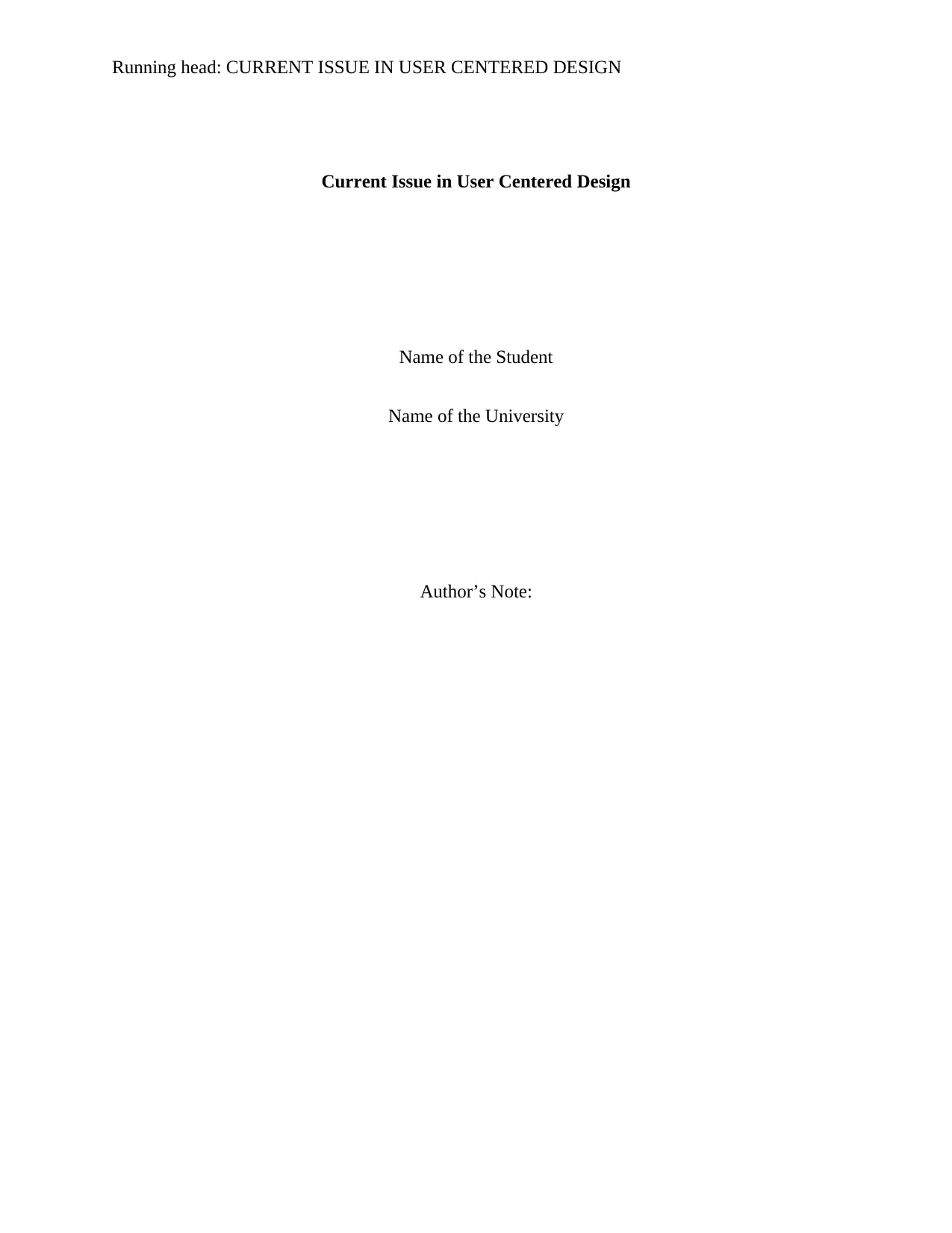
Running head: CURRENT ISSUE IN USER CENTERED DESIGN
Current Issue in User Centered Design
Name of the Student
Name of the University
Author’s Note:
Current Issue in User Centered Design
Name of the Student
Name of the University
Author’s Note:
Paraphrase This Document
Need a fresh take? Get an instant paraphrase of this document with our AI Paraphraser
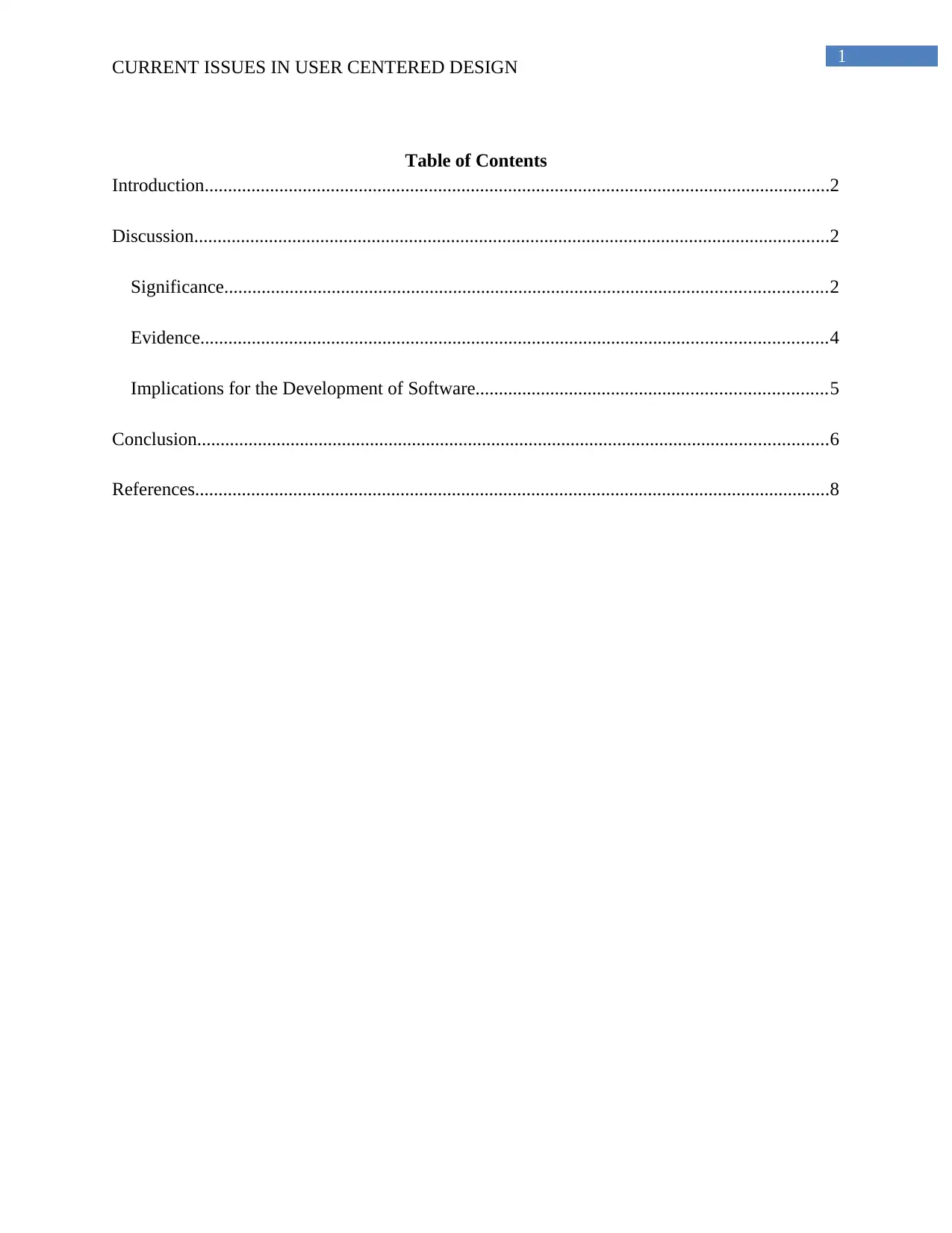
1
CURRENT ISSUES IN USER CENTERED DESIGN
Table of Contents
Introduction......................................................................................................................................2
Discussion........................................................................................................................................2
Significance.................................................................................................................................2
Evidence......................................................................................................................................4
Implications for the Development of Software...........................................................................5
Conclusion.......................................................................................................................................6
References........................................................................................................................................8
CURRENT ISSUES IN USER CENTERED DESIGN
Table of Contents
Introduction......................................................................................................................................2
Discussion........................................................................................................................................2
Significance.................................................................................................................................2
Evidence......................................................................................................................................4
Implications for the Development of Software...........................................................................5
Conclusion.......................................................................................................................................6
References........................................................................................................................................8
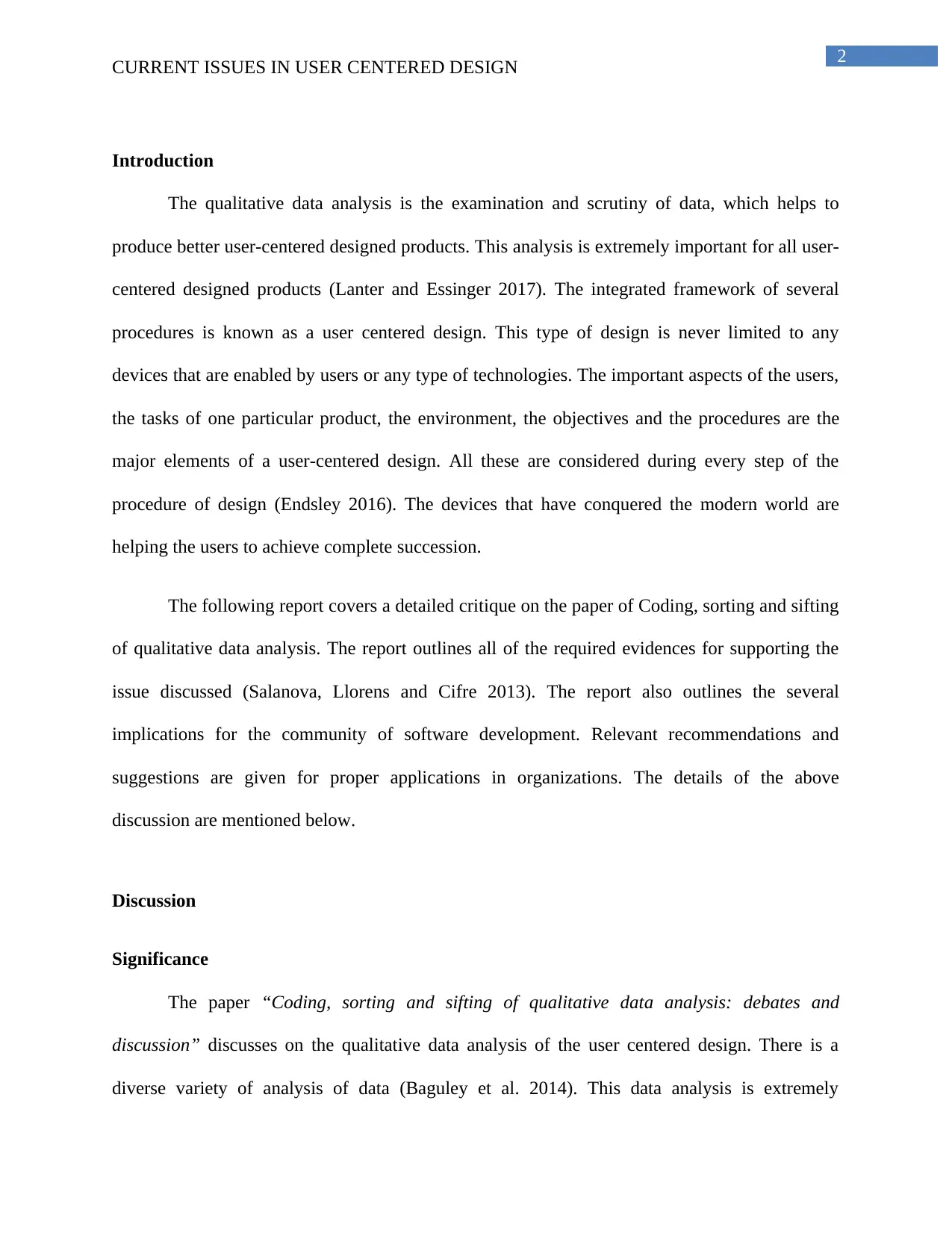
2
CURRENT ISSUES IN USER CENTERED DESIGN
Introduction
The qualitative data analysis is the examination and scrutiny of data, which helps to
produce better user-centered designed products. This analysis is extremely important for all user-
centered designed products (Lanter and Essinger 2017). The integrated framework of several
procedures is known as a user centered design. This type of design is never limited to any
devices that are enabled by users or any type of technologies. The important aspects of the users,
the tasks of one particular product, the environment, the objectives and the procedures are the
major elements of a user-centered design. All these are considered during every step of the
procedure of design (Endsley 2016). The devices that have conquered the modern world are
helping the users to achieve complete succession.
The following report covers a detailed critique on the paper of Coding, sorting and sifting
of qualitative data analysis. The report outlines all of the required evidences for supporting the
issue discussed (Salanova, Llorens and Cifre 2013). The report also outlines the several
implications for the community of software development. Relevant recommendations and
suggestions are given for proper applications in organizations. The details of the above
discussion are mentioned below.
Discussion
Significance
The paper “Coding, sorting and sifting of qualitative data analysis: debates and
discussion” discusses on the qualitative data analysis of the user centered design. There is a
diverse variety of analysis of data (Baguley et al. 2014). This data analysis is extremely
CURRENT ISSUES IN USER CENTERED DESIGN
Introduction
The qualitative data analysis is the examination and scrutiny of data, which helps to
produce better user-centered designed products. This analysis is extremely important for all user-
centered designed products (Lanter and Essinger 2017). The integrated framework of several
procedures is known as a user centered design. This type of design is never limited to any
devices that are enabled by users or any type of technologies. The important aspects of the users,
the tasks of one particular product, the environment, the objectives and the procedures are the
major elements of a user-centered design. All these are considered during every step of the
procedure of design (Endsley 2016). The devices that have conquered the modern world are
helping the users to achieve complete succession.
The following report covers a detailed critique on the paper of Coding, sorting and sifting
of qualitative data analysis. The report outlines all of the required evidences for supporting the
issue discussed (Salanova, Llorens and Cifre 2013). The report also outlines the several
implications for the community of software development. Relevant recommendations and
suggestions are given for proper applications in organizations. The details of the above
discussion are mentioned below.
Discussion
Significance
The paper “Coding, sorting and sifting of qualitative data analysis: debates and
discussion” discusses on the qualitative data analysis of the user centered design. There is a
diverse variety of analysis of data (Baguley et al. 2014). This data analysis is extremely
⊘ This is a preview!⊘
Do you want full access?
Subscribe today to unlock all pages.

Trusted by 1+ million students worldwide
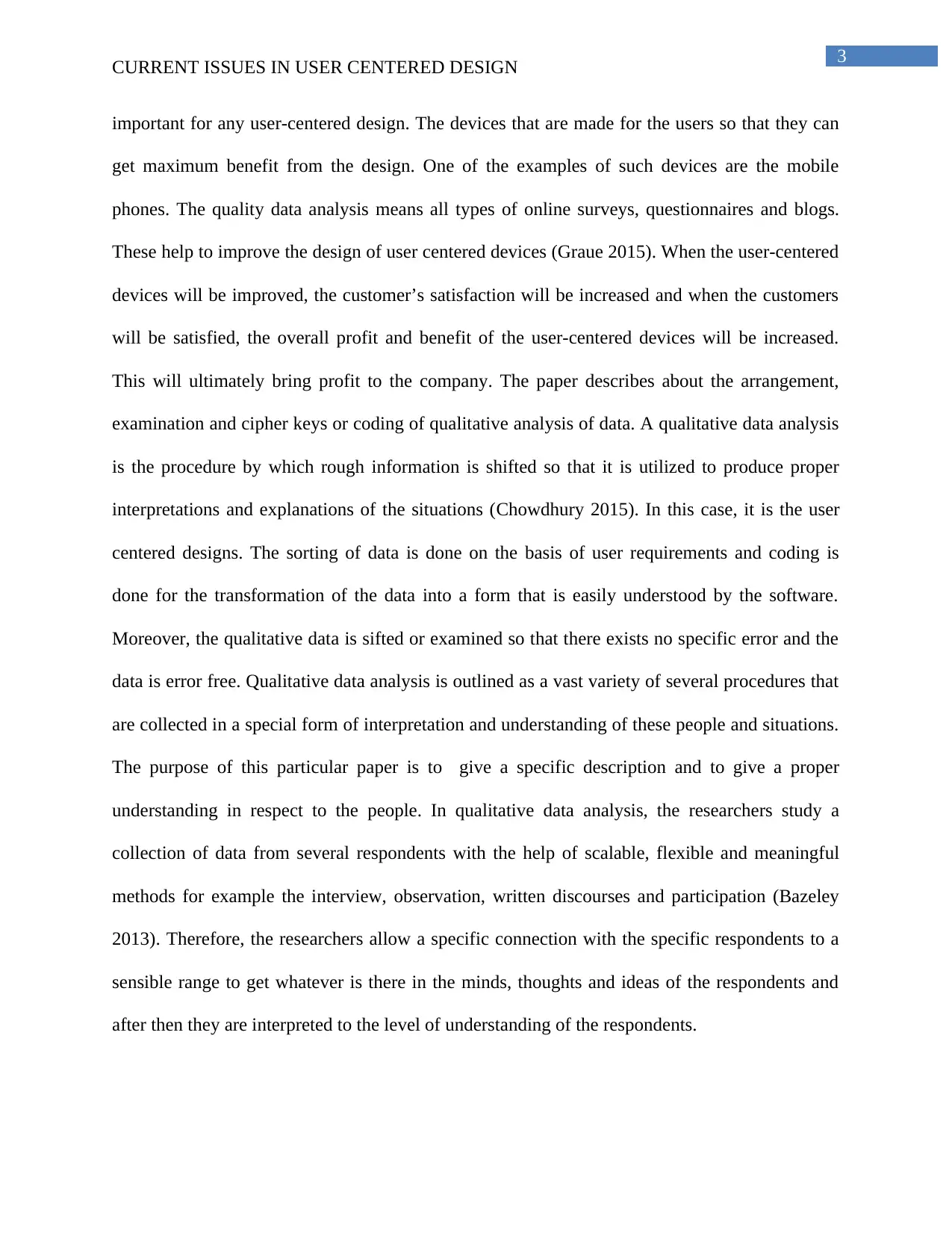
3
CURRENT ISSUES IN USER CENTERED DESIGN
important for any user-centered design. The devices that are made for the users so that they can
get maximum benefit from the design. One of the examples of such devices are the mobile
phones. The quality data analysis means all types of online surveys, questionnaires and blogs.
These help to improve the design of user centered devices (Graue 2015). When the user-centered
devices will be improved, the customer’s satisfaction will be increased and when the customers
will be satisfied, the overall profit and benefit of the user-centered devices will be increased.
This will ultimately bring profit to the company. The paper describes about the arrangement,
examination and cipher keys or coding of qualitative analysis of data. A qualitative data analysis
is the procedure by which rough information is shifted so that it is utilized to produce proper
interpretations and explanations of the situations (Chowdhury 2015). In this case, it is the user
centered designs. The sorting of data is done on the basis of user requirements and coding is
done for the transformation of the data into a form that is easily understood by the software.
Moreover, the qualitative data is sifted or examined so that there exists no specific error and the
data is error free. Qualitative data analysis is outlined as a vast variety of several procedures that
are collected in a special form of interpretation and understanding of these people and situations.
The purpose of this particular paper is to give a specific description and to give a proper
understanding in respect to the people. In qualitative data analysis, the researchers study a
collection of data from several respondents with the help of scalable, flexible and meaningful
methods for example the interview, observation, written discourses and participation (Bazeley
2013). Therefore, the researchers allow a specific connection with the specific respondents to a
sensible range to get whatever is there in the minds, thoughts and ideas of the respondents and
after then they are interpreted to the level of understanding of the respondents.
CURRENT ISSUES IN USER CENTERED DESIGN
important for any user-centered design. The devices that are made for the users so that they can
get maximum benefit from the design. One of the examples of such devices are the mobile
phones. The quality data analysis means all types of online surveys, questionnaires and blogs.
These help to improve the design of user centered devices (Graue 2015). When the user-centered
devices will be improved, the customer’s satisfaction will be increased and when the customers
will be satisfied, the overall profit and benefit of the user-centered devices will be increased.
This will ultimately bring profit to the company. The paper describes about the arrangement,
examination and cipher keys or coding of qualitative analysis of data. A qualitative data analysis
is the procedure by which rough information is shifted so that it is utilized to produce proper
interpretations and explanations of the situations (Chowdhury 2015). In this case, it is the user
centered designs. The sorting of data is done on the basis of user requirements and coding is
done for the transformation of the data into a form that is easily understood by the software.
Moreover, the qualitative data is sifted or examined so that there exists no specific error and the
data is error free. Qualitative data analysis is outlined as a vast variety of several procedures that
are collected in a special form of interpretation and understanding of these people and situations.
The purpose of this particular paper is to give a specific description and to give a proper
understanding in respect to the people. In qualitative data analysis, the researchers study a
collection of data from several respondents with the help of scalable, flexible and meaningful
methods for example the interview, observation, written discourses and participation (Bazeley
2013). Therefore, the researchers allow a specific connection with the specific respondents to a
sensible range to get whatever is there in the minds, thoughts and ideas of the respondents and
after then they are interpreted to the level of understanding of the respondents.
Paraphrase This Document
Need a fresh take? Get an instant paraphrase of this document with our AI Paraphraser
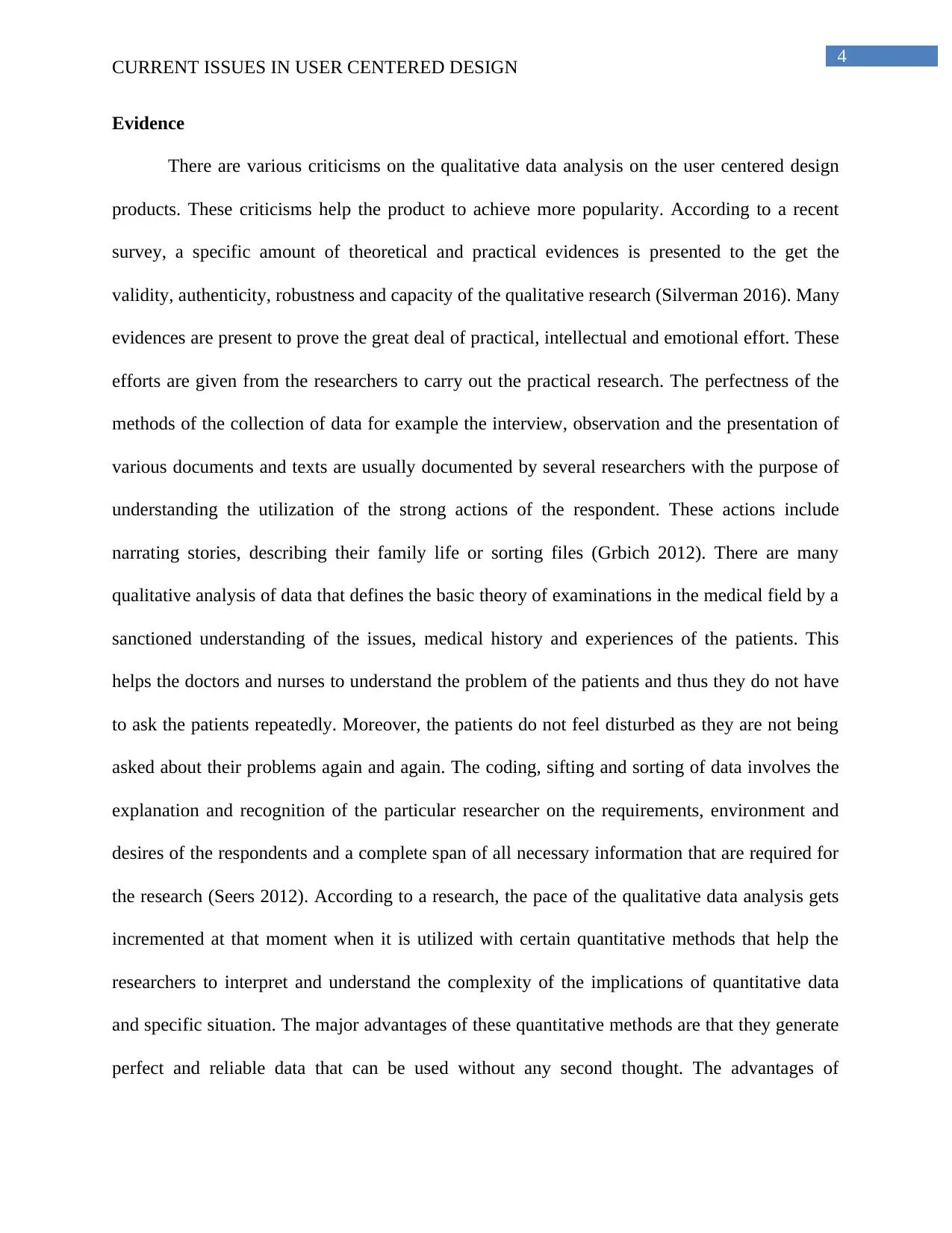
4
CURRENT ISSUES IN USER CENTERED DESIGN
Evidence
There are various criticisms on the qualitative data analysis on the user centered design
products. These criticisms help the product to achieve more popularity. According to a recent
survey, a specific amount of theoretical and practical evidences is presented to the get the
validity, authenticity, robustness and capacity of the qualitative research (Silverman 2016). Many
evidences are present to prove the great deal of practical, intellectual and emotional effort. These
efforts are given from the researchers to carry out the practical research. The perfectness of the
methods of the collection of data for example the interview, observation and the presentation of
various documents and texts are usually documented by several researchers with the purpose of
understanding the utilization of the strong actions of the respondent. These actions include
narrating stories, describing their family life or sorting files (Grbich 2012). There are many
qualitative analysis of data that defines the basic theory of examinations in the medical field by a
sanctioned understanding of the issues, medical history and experiences of the patients. This
helps the doctors and nurses to understand the problem of the patients and thus they do not have
to ask the patients repeatedly. Moreover, the patients do not feel disturbed as they are not being
asked about their problems again and again. The coding, sifting and sorting of data involves the
explanation and recognition of the particular researcher on the requirements, environment and
desires of the respondents and a complete span of all necessary information that are required for
the research (Seers 2012). According to a research, the pace of the qualitative data analysis gets
incremented at that moment when it is utilized with certain quantitative methods that help the
researchers to interpret and understand the complexity of the implications of quantitative data
and specific situation. The major advantages of these quantitative methods are that they generate
perfect and reliable data that can be used without any second thought. The advantages of
CURRENT ISSUES IN USER CENTERED DESIGN
Evidence
There are various criticisms on the qualitative data analysis on the user centered design
products. These criticisms help the product to achieve more popularity. According to a recent
survey, a specific amount of theoretical and practical evidences is presented to the get the
validity, authenticity, robustness and capacity of the qualitative research (Silverman 2016). Many
evidences are present to prove the great deal of practical, intellectual and emotional effort. These
efforts are given from the researchers to carry out the practical research. The perfectness of the
methods of the collection of data for example the interview, observation and the presentation of
various documents and texts are usually documented by several researchers with the purpose of
understanding the utilization of the strong actions of the respondent. These actions include
narrating stories, describing their family life or sorting files (Grbich 2012). There are many
qualitative analysis of data that defines the basic theory of examinations in the medical field by a
sanctioned understanding of the issues, medical history and experiences of the patients. This
helps the doctors and nurses to understand the problem of the patients and thus they do not have
to ask the patients repeatedly. Moreover, the patients do not feel disturbed as they are not being
asked about their problems again and again. The coding, sifting and sorting of data involves the
explanation and recognition of the particular researcher on the requirements, environment and
desires of the respondents and a complete span of all necessary information that are required for
the research (Seers 2012). According to a research, the pace of the qualitative data analysis gets
incremented at that moment when it is utilized with certain quantitative methods that help the
researchers to interpret and understand the complexity of the implications of quantitative data
and specific situation. The major advantages of these quantitative methods are that they generate
perfect and reliable data that can be used without any second thought. The advantages of
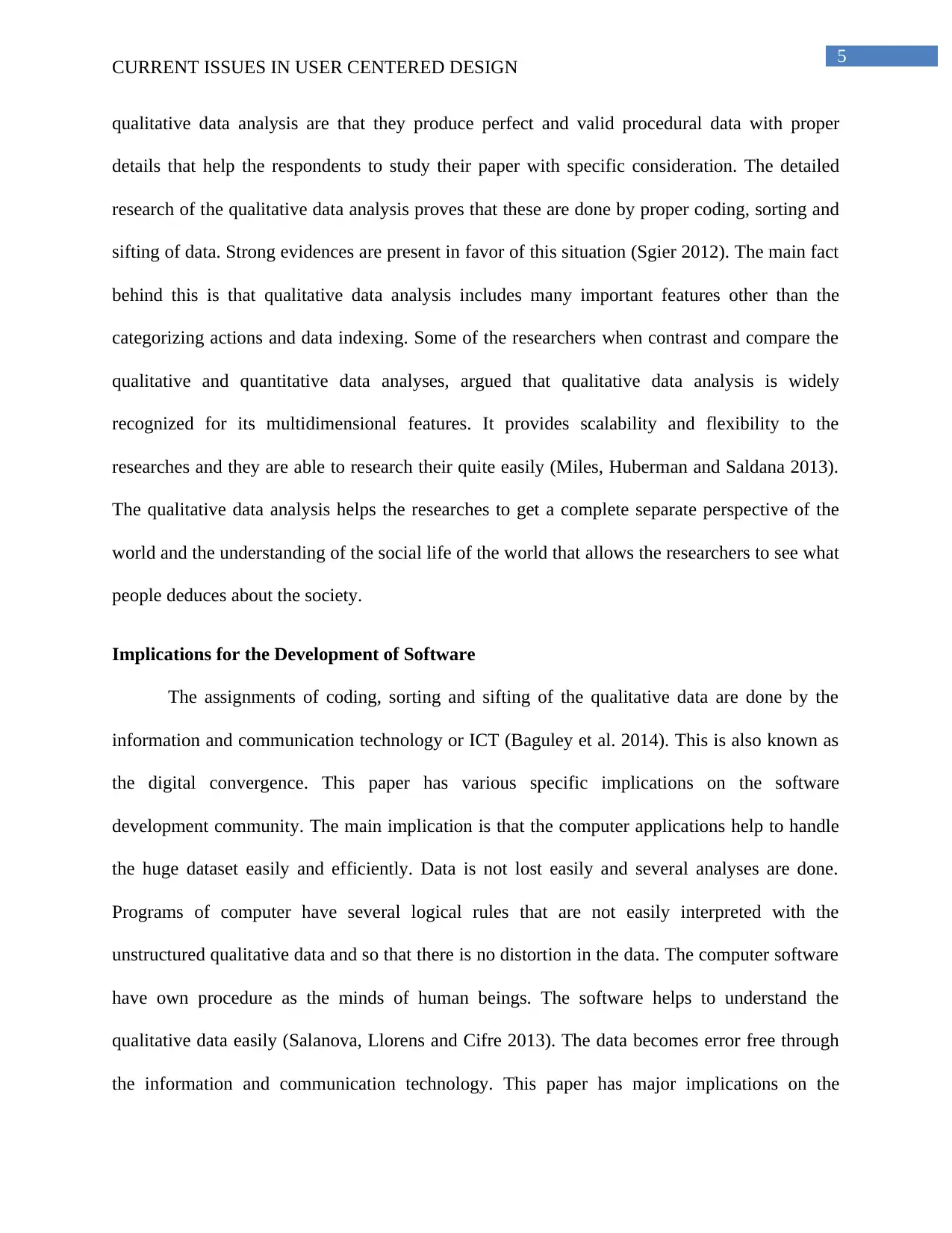
5
CURRENT ISSUES IN USER CENTERED DESIGN
qualitative data analysis are that they produce perfect and valid procedural data with proper
details that help the respondents to study their paper with specific consideration. The detailed
research of the qualitative data analysis proves that these are done by proper coding, sorting and
sifting of data. Strong evidences are present in favor of this situation (Sgier 2012). The main fact
behind this is that qualitative data analysis includes many important features other than the
categorizing actions and data indexing. Some of the researchers when contrast and compare the
qualitative and quantitative data analyses, argued that qualitative data analysis is widely
recognized for its multidimensional features. It provides scalability and flexibility to the
researches and they are able to research their quite easily (Miles, Huberman and Saldana 2013).
The qualitative data analysis helps the researches to get a complete separate perspective of the
world and the understanding of the social life of the world that allows the researchers to see what
people deduces about the society.
Implications for the Development of Software
The assignments of coding, sorting and sifting of the qualitative data are done by the
information and communication technology or ICT (Baguley et al. 2014). This is also known as
the digital convergence. This paper has various specific implications on the software
development community. The main implication is that the computer applications help to handle
the huge dataset easily and efficiently. Data is not lost easily and several analyses are done.
Programs of computer have several logical rules that are not easily interpreted with the
unstructured qualitative data and so that there is no distortion in the data. The computer software
have own procedure as the minds of human beings. The software helps to understand the
qualitative data easily (Salanova, Llorens and Cifre 2013). The data becomes error free through
the information and communication technology. This paper has major implications on the
CURRENT ISSUES IN USER CENTERED DESIGN
qualitative data analysis are that they produce perfect and valid procedural data with proper
details that help the respondents to study their paper with specific consideration. The detailed
research of the qualitative data analysis proves that these are done by proper coding, sorting and
sifting of data. Strong evidences are present in favor of this situation (Sgier 2012). The main fact
behind this is that qualitative data analysis includes many important features other than the
categorizing actions and data indexing. Some of the researchers when contrast and compare the
qualitative and quantitative data analyses, argued that qualitative data analysis is widely
recognized for its multidimensional features. It provides scalability and flexibility to the
researches and they are able to research their quite easily (Miles, Huberman and Saldana 2013).
The qualitative data analysis helps the researches to get a complete separate perspective of the
world and the understanding of the social life of the world that allows the researchers to see what
people deduces about the society.
Implications for the Development of Software
The assignments of coding, sorting and sifting of the qualitative data are done by the
information and communication technology or ICT (Baguley et al. 2014). This is also known as
the digital convergence. This paper has various specific implications on the software
development community. The main implication is that the computer applications help to handle
the huge dataset easily and efficiently. Data is not lost easily and several analyses are done.
Programs of computer have several logical rules that are not easily interpreted with the
unstructured qualitative data and so that there is no distortion in the data. The computer software
have own procedure as the minds of human beings. The software helps to understand the
qualitative data easily (Salanova, Llorens and Cifre 2013). The data becomes error free through
the information and communication technology. This paper has major implications on the
⊘ This is a preview!⊘
Do you want full access?
Subscribe today to unlock all pages.

Trusted by 1+ million students worldwide
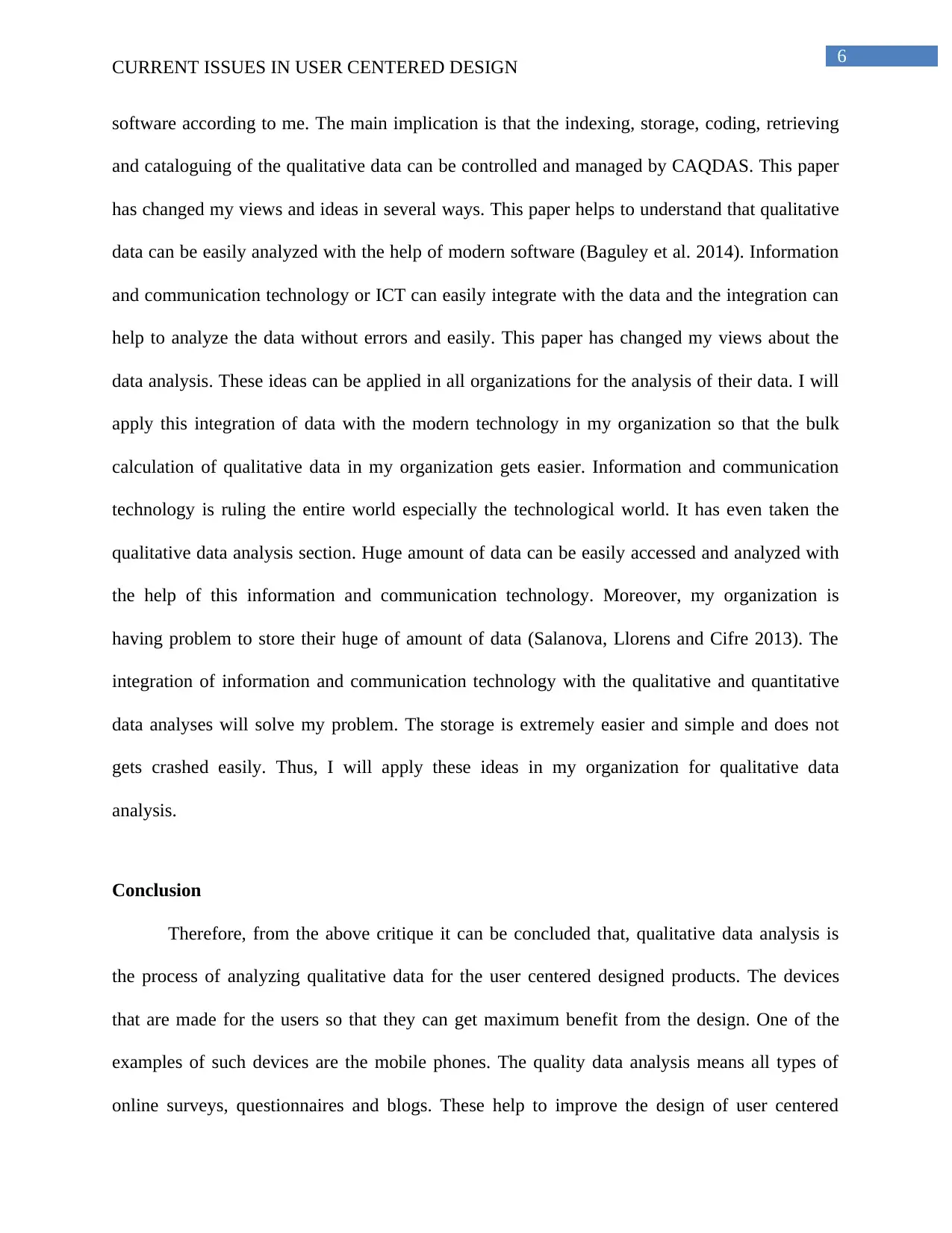
6
CURRENT ISSUES IN USER CENTERED DESIGN
software according to me. The main implication is that the indexing, storage, coding, retrieving
and cataloguing of the qualitative data can be controlled and managed by CAQDAS. This paper
has changed my views and ideas in several ways. This paper helps to understand that qualitative
data can be easily analyzed with the help of modern software (Baguley et al. 2014). Information
and communication technology or ICT can easily integrate with the data and the integration can
help to analyze the data without errors and easily. This paper has changed my views about the
data analysis. These ideas can be applied in all organizations for the analysis of their data. I will
apply this integration of data with the modern technology in my organization so that the bulk
calculation of qualitative data in my organization gets easier. Information and communication
technology is ruling the entire world especially the technological world. It has even taken the
qualitative data analysis section. Huge amount of data can be easily accessed and analyzed with
the help of this information and communication technology. Moreover, my organization is
having problem to store their huge of amount of data (Salanova, Llorens and Cifre 2013). The
integration of information and communication technology with the qualitative and quantitative
data analyses will solve my problem. The storage is extremely easier and simple and does not
gets crashed easily. Thus, I will apply these ideas in my organization for qualitative data
analysis.
Conclusion
Therefore, from the above critique it can be concluded that, qualitative data analysis is
the process of analyzing qualitative data for the user centered designed products. The devices
that are made for the users so that they can get maximum benefit from the design. One of the
examples of such devices are the mobile phones. The quality data analysis means all types of
online surveys, questionnaires and blogs. These help to improve the design of user centered
CURRENT ISSUES IN USER CENTERED DESIGN
software according to me. The main implication is that the indexing, storage, coding, retrieving
and cataloguing of the qualitative data can be controlled and managed by CAQDAS. This paper
has changed my views and ideas in several ways. This paper helps to understand that qualitative
data can be easily analyzed with the help of modern software (Baguley et al. 2014). Information
and communication technology or ICT can easily integrate with the data and the integration can
help to analyze the data without errors and easily. This paper has changed my views about the
data analysis. These ideas can be applied in all organizations for the analysis of their data. I will
apply this integration of data with the modern technology in my organization so that the bulk
calculation of qualitative data in my organization gets easier. Information and communication
technology is ruling the entire world especially the technological world. It has even taken the
qualitative data analysis section. Huge amount of data can be easily accessed and analyzed with
the help of this information and communication technology. Moreover, my organization is
having problem to store their huge of amount of data (Salanova, Llorens and Cifre 2013). The
integration of information and communication technology with the qualitative and quantitative
data analyses will solve my problem. The storage is extremely easier and simple and does not
gets crashed easily. Thus, I will apply these ideas in my organization for qualitative data
analysis.
Conclusion
Therefore, from the above critique it can be concluded that, qualitative data analysis is
the process of analyzing qualitative data for the user centered designed products. The devices
that are made for the users so that they can get maximum benefit from the design. One of the
examples of such devices are the mobile phones. The quality data analysis means all types of
online surveys, questionnaires and blogs. These help to improve the design of user centered
Paraphrase This Document
Need a fresh take? Get an instant paraphrase of this document with our AI Paraphraser
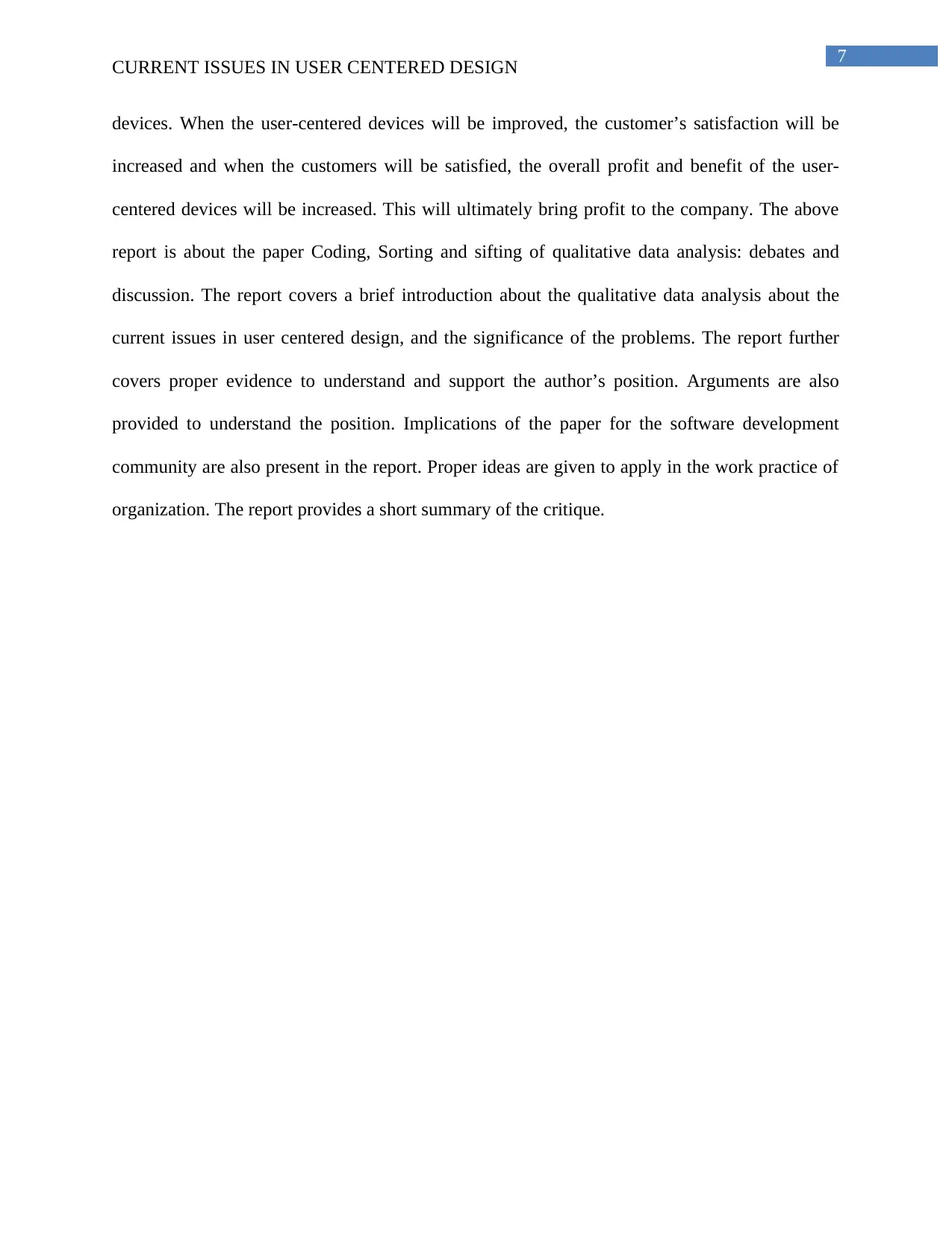
7
CURRENT ISSUES IN USER CENTERED DESIGN
devices. When the user-centered devices will be improved, the customer’s satisfaction will be
increased and when the customers will be satisfied, the overall profit and benefit of the user-
centered devices will be increased. This will ultimately bring profit to the company. The above
report is about the paper Coding, Sorting and sifting of qualitative data analysis: debates and
discussion. The report covers a brief introduction about the qualitative data analysis about the
current issues in user centered design, and the significance of the problems. The report further
covers proper evidence to understand and support the author’s position. Arguments are also
provided to understand the position. Implications of the paper for the software development
community are also present in the report. Proper ideas are given to apply in the work practice of
organization. The report provides a short summary of the critique.
CURRENT ISSUES IN USER CENTERED DESIGN
devices. When the user-centered devices will be improved, the customer’s satisfaction will be
increased and when the customers will be satisfied, the overall profit and benefit of the user-
centered devices will be increased. This will ultimately bring profit to the company. The above
report is about the paper Coding, Sorting and sifting of qualitative data analysis: debates and
discussion. The report covers a brief introduction about the qualitative data analysis about the
current issues in user centered design, and the significance of the problems. The report further
covers proper evidence to understand and support the author’s position. Arguments are also
provided to understand the position. Implications of the paper for the software development
community are also present in the report. Proper ideas are given to apply in the work practice of
organization. The report provides a short summary of the critique.
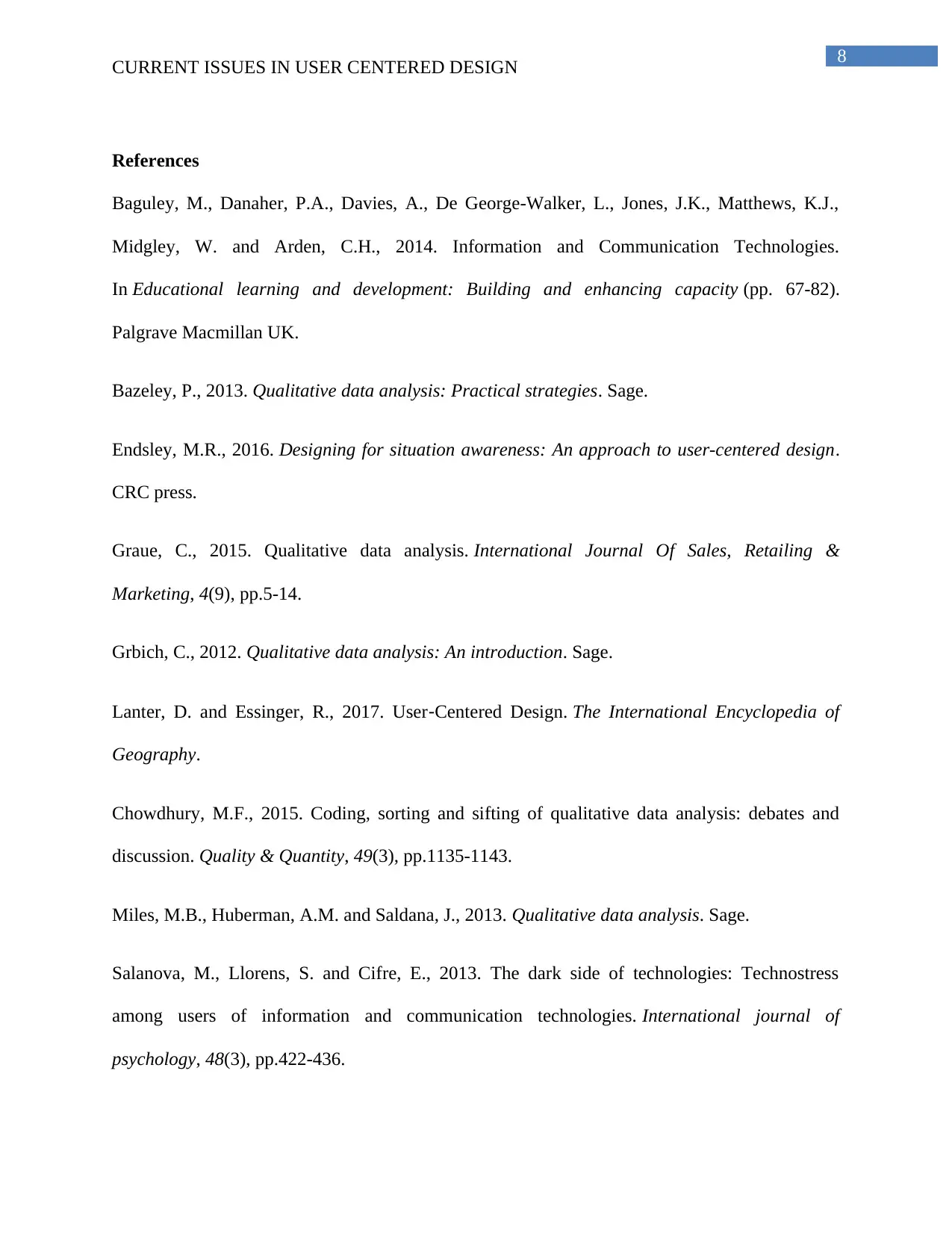
8
CURRENT ISSUES IN USER CENTERED DESIGN
References
Baguley, M., Danaher, P.A., Davies, A., De George-Walker, L., Jones, J.K., Matthews, K.J.,
Midgley, W. and Arden, C.H., 2014. Information and Communication Technologies.
In Educational learning and development: Building and enhancing capacity (pp. 67-82).
Palgrave Macmillan UK.
Bazeley, P., 2013. Qualitative data analysis: Practical strategies. Sage.
Endsley, M.R., 2016. Designing for situation awareness: An approach to user-centered design.
CRC press.
Graue, C., 2015. Qualitative data analysis. International Journal Of Sales, Retailing &
Marketing, 4(9), pp.5-14.
Grbich, C., 2012. Qualitative data analysis: An introduction. Sage.
Lanter, D. and Essinger, R., 2017. User‐Centered Design. The International Encyclopedia of
Geography.
Chowdhury, M.F., 2015. Coding, sorting and sifting of qualitative data analysis: debates and
discussion. Quality & Quantity, 49(3), pp.1135-1143.
Miles, M.B., Huberman, A.M. and Saldana, J., 2013. Qualitative data analysis. Sage.
Salanova, M., Llorens, S. and Cifre, E., 2013. The dark side of technologies: Technostress
among users of information and communication technologies. International journal of
psychology, 48(3), pp.422-436.
CURRENT ISSUES IN USER CENTERED DESIGN
References
Baguley, M., Danaher, P.A., Davies, A., De George-Walker, L., Jones, J.K., Matthews, K.J.,
Midgley, W. and Arden, C.H., 2014. Information and Communication Technologies.
In Educational learning and development: Building and enhancing capacity (pp. 67-82).
Palgrave Macmillan UK.
Bazeley, P., 2013. Qualitative data analysis: Practical strategies. Sage.
Endsley, M.R., 2016. Designing for situation awareness: An approach to user-centered design.
CRC press.
Graue, C., 2015. Qualitative data analysis. International Journal Of Sales, Retailing &
Marketing, 4(9), pp.5-14.
Grbich, C., 2012. Qualitative data analysis: An introduction. Sage.
Lanter, D. and Essinger, R., 2017. User‐Centered Design. The International Encyclopedia of
Geography.
Chowdhury, M.F., 2015. Coding, sorting and sifting of qualitative data analysis: debates and
discussion. Quality & Quantity, 49(3), pp.1135-1143.
Miles, M.B., Huberman, A.M. and Saldana, J., 2013. Qualitative data analysis. Sage.
Salanova, M., Llorens, S. and Cifre, E., 2013. The dark side of technologies: Technostress
among users of information and communication technologies. International journal of
psychology, 48(3), pp.422-436.
⊘ This is a preview!⊘
Do you want full access?
Subscribe today to unlock all pages.

Trusted by 1+ million students worldwide

9
CURRENT ISSUES IN USER CENTERED DESIGN
Seers, K., 2012. Qualitative data analysis. Evidence-based nursing, 15(1), pp.2-2.
Sgier, L., 2012. Qualitative data analysis.
Silverman, D. ed., 2016. Qualitative research. Sage.
CURRENT ISSUES IN USER CENTERED DESIGN
Seers, K., 2012. Qualitative data analysis. Evidence-based nursing, 15(1), pp.2-2.
Sgier, L., 2012. Qualitative data analysis.
Silverman, D. ed., 2016. Qualitative research. Sage.
1 out of 10
Related Documents
Your All-in-One AI-Powered Toolkit for Academic Success.
+13062052269
info@desklib.com
Available 24*7 on WhatsApp / Email
![[object Object]](/_next/static/media/star-bottom.7253800d.svg)
Unlock your academic potential
Copyright © 2020–2025 A2Z Services. All Rights Reserved. Developed and managed by ZUCOL.




